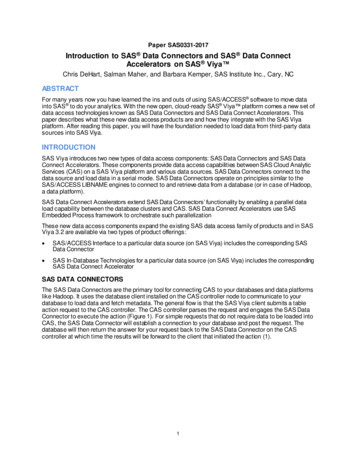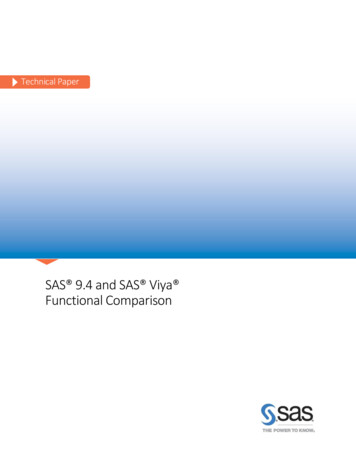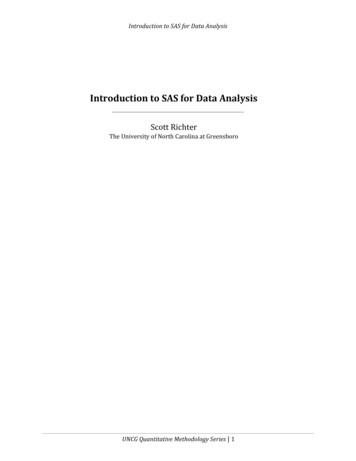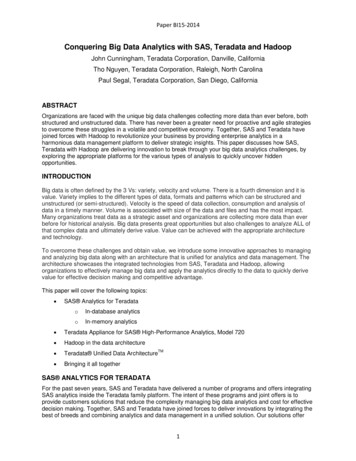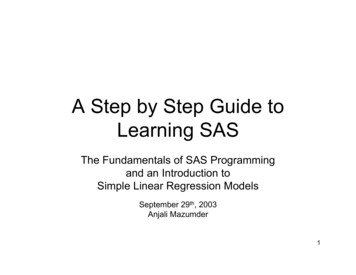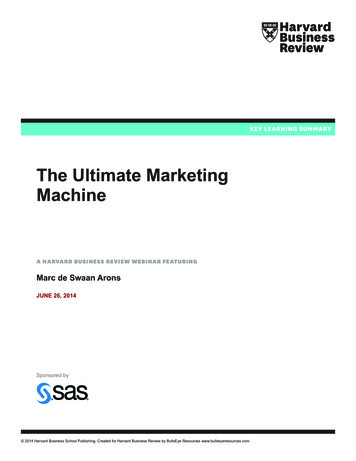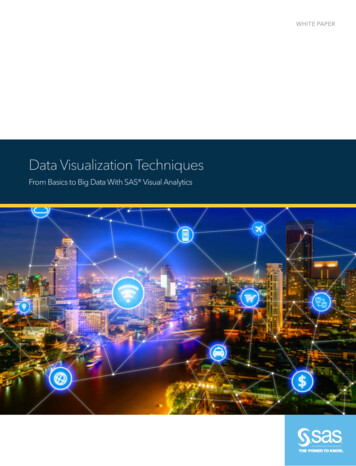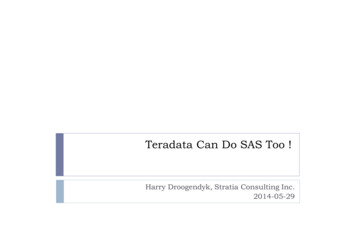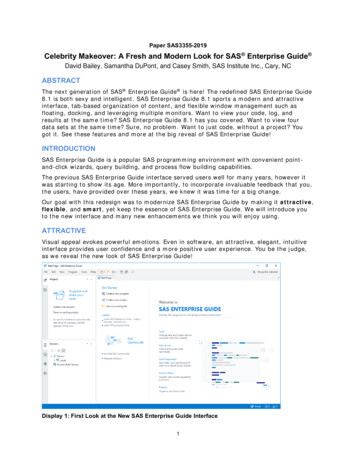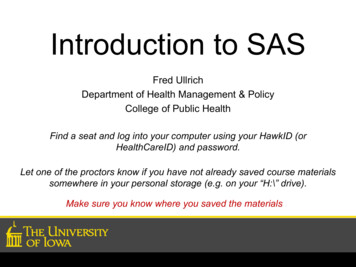
Transcription
Introduction to SASFred UllrichDepartment of Health Management & PolicyCollege of Public HealthFind a seat and log into your computer using your HawkID (orHealthCareID) and password.Let one of the proctors know if you have not already saved course materialssomewhere in your personal storage (e.g. on your “H:\” drive).Make sure you know where you saved the materials
”a software suitedeveloped by SASInstitute for advancedanalytics, multivariateanalyses, businessintelligence, datamanagement, andpredictive analytics.”
”a software suitedeveloped by SASInstitute for advancedanalytics, multivariateanalyses, businessintelligence, datamanagement, andpredictive analytics.”
Overview Day 1– Introduction to SAS– Data Management Day 2– Introduction to SAS Procedures– ODS Graphics Designer– Demonstration of SAS EG
Uses Access and manage data acrossmultiple sources Generate reports andperform analyses
Interfaces SAS Windowing Environment(SAS)– Provides a full programming interface SAS Enterprise Guide(SAS EG)– Provides a point-and-click interface withmenus and wizards to create code
Access at UI PC Installation– SAS for training and Research at UI is “free”Contact your IT support people 272 for administrative use Virtual Desktop– Provides access to a variety of programs through webbased system– Used on or off campus Research Remote Desktop Service (RRDS) Sign-up: https://workflow.uiowa.edu/form/rrdsrequest
Starting the SAS System Off campus– Virtual Desktop http://virtualdesktop.uiowa.edu/ Requires installation of Citrix Receiver software PC installed or on campus– Start All Programs SAS SAS 9.4or– Start button “S” SAS SAS 9.4
It’s not magic it’s a toolSASOutput
Interface Windows Enhanced EditorLogOutput or Results ViewerExplorerResults
Enhanced Editor Where you write your SAS programs A SAS program is a series ofcommands to:– Import and manipulate data– Generate reports and perform analyses– Output results
Log Information pertaining to the programyou’ve submitted is automaticallydisplayed in the log Contains a list of:– Program commands and operations– Notes, warnings and errors
Output or Results Viewer When the SAS program executeswithout error, the results are displayedin the Output or Results Viewer The window the results will bedisplayed in will depend on the defaultsetting
Output or Results ViewerOutputResults Viewer
Results Provides table of contents for output Lists each procedure in outline form Can be expanded to show each part
Explorer Provides easy access to SAS filesand data sets Computerprovides access to allshared devices or drives Librariescontains all librariescurrently defined
Obtain DataWrite or openprogramSubmit theprogramView logDebug ormodify theprogramView results
Obtain DataWrite or openprogramSubmit theprogramView logDebug ormodify theprogramView results
Becoming a SAS Programmer SAS is best as a “write code then run”program To be proficient, you must learn howto write a program– Simple if you understand what isrequired
My First ProgramMy HouseNorth ParkElementary
A Basic SAS Program Find data Read data create a dataset “Clean” data Make output
A Basic SAS Program Find dataRead data create a dataset“Clean” dataMake outputPre-writtenroutines fordata analysis &processingCreates and/ormodifiesSAS data setsDataStepProc Step
Data (1)Layout Columns Variables Rows ObservationsBill10155 165.10Tom15635 132.56Sue204 125 115.89Ann24578 155.25Jill39732 112.90Bob45644 118.21Tim67867 156.20Matt87595 134.00Kay94188 122.45
Data (2)Variables need names 1-32 characters Must start with a character orunderscore– Subsequent characters can beletters, numbers, or underscores No blanks or special characters Mixed-case OK Are not case sensitivefname id days wagesBill101 55 165.10Tom15635 132.56Sue204 125 115.89Ann24578 155.25Jill39732 112.90Bob45644 118.21Tim67867 156.20Matt87595 134.00Kay94188 122.45
Data (3)Data types Character– Can contain any character (letters,numbers, special characters, andblanks)– Length from 1-32,767 characters Numeric– Numbers (decimal point and minussign)fname id days wagesBill101 55 165.10Tom15635 132.56Sue204 125 115.89Ann24578 155.25Jill39732 112.90Bob45644 118.21Tim67867 156.20Matt87595 134.00Kay94188 122.45
Data (4)Data sources Internal– Data embedded with a program External– “Local” Excel, Access, delimited, text– “Remote” Databases, servers, etc.fname id days wagesBill101 55 165.10Tom15635 132.56Sue204 125 115.89Ann24578 155.25Jill39732 112.90Bob45644 118.21Tim67867 156.20Matt87595 134.00Kay94188 122.45
Let’s Write a Program!BillTomSueAnnJillBobTimMattKay101 55 165.10156 35 132.56204 125 115.89245 78 155.25397 32 112.90456 44 118.21678 67 156.20875 95 134.00941 88 122.45
Let’s Write a Program!Use the “data”statement to tell SASthat you want tocreate a dataset andyou want to name it“demo”.Datasets neednames data demo;BillTomSueAnnJillBobTimMattKay101 55 165.10156 35 132.56204 125 115.89245 78 155.25397 32 112.90456 44 118.21678 67 156.20875 95 134.00941 88 122.45
DatasetsA “special” type of file that SAS creates and uses for itsown purposes.Datasets need names: 1-32 charactersMust start with a character or underscore– Subsequent characters can be letters, numbers, or underscoresNo blanks or special charactersMixed-case OKAre not case sensitive
Let’s Write a Program!Use the “input”statement to tell SAShow to read in eachline of the data file. Thisis where you providevariable names andwhere you tell SAS thetype of each variable.data demo;input fname id days wages;BillTomSueAnnJillBobTimMattKay101 55 165.10156 35 132.56204 125 115.89245 78 155.25397 32 112.90456 44 118.21678 67 156.20875 95 134.00941 88 122.45
Let’s Write a Program!The “datalines”statement tells SASthat the next lines ofthe program actuallycontain data.SAS will treat each lineas a new observationuntil it encounters asemi-colon (;)data demo;input fname id days wages;datalines;Bill101 55 165.10Tom 156 35 132.56Sue204 125 115.89Ann 245 78 155.25Jill397 32 112.90Bob 456 44 118.21Tim678 67 156.20Matt 875 95 134.00Kay941 88 122.45;
Let’s Write a Program!The “run” statementisn’t always necessary,but it’s a good practiceto tell SAS that this isthe end of the DATAstep or PROC step.data demo;input fname id days wages;datalines;Bill101 55 165.10Tom 156 35 132.56Sue204 125 115.89Ann 245 78 155.25Jill397 32 112.90Bob 456 44 118.21Tim678 67 156.20Matt 875 95 134.00Kay941 88 122.45;run;
Let’s Write a Program!Now that our programhas detailed how to getour data into a SASdataset, we can askSAS to run a simplePROC to see what thedata looks like.Again, the “run”statement isn’t alwaysnecessary, but it’s agood practice to tellSAS that this is the endof the DATA step orPROC step.data demo;input fname id days wages;cards;Bill101 55 165.10Tom 156 35 132.56Sue204 125 115.89Ann 245 78 155.25Jill397 32 112.90Bob 456 44 118.21Tim678 67 156.20Matt 875 95 134.00Kay941 88 122.45;run;proc print;run;
Obtain DataWrite or opena programSubmit theprogramView logDebug ormodify theprogramView results
Submitting the ProgramSAVE EARLY, SAVE OFTEN! Can submit all or part of a program Click the “running man”
09Kay94188122.45
Obtain DataWrite or opena programSubmit theprogramView logDebug ormodify theprogramView results
LogNOTE: Copyright (c) 2002-2012 by SAS Institute Inc., Cary, NC, USA.NOTE: SAS (r) Proprietary Software 9.4 (TS1M3)Licensed to UNIVERSITY OF IOWA - SFA T&R, Site 70086217.NOTE: This session is executing on the X64 7PRO platform.NOTE: Additional host information:X64 7PRO WIN 6.1.7601 Service Pack 1 WorkstationNOTE: SAS initialization used:real time0.65 secondscpu time0.49 seconds123data demo;input fname id days wages;datalines;NOTE: The data set WORK.DEMO has 9 observations and 4 variables.NOTE: DATA statement used (Total process time):real time0.01 secondscpu time0.01 seconds1314151617;run;proc print;run;NOTE: There were 9 observations read from the data set WORK.DEMO.NOTE: PROCEDURE PRINT used (Total process time):real time0.42 secondscpu time0.14 seconds
Time to do some data fixing!
Assignment Statements Basic method for adding to or modifying a SASdata set Has the formVariable expression;– Numeric valueYear 2018;– Character valueStudy “Heart”;– Copy a variableNewvariable Oldvariable;
Arithmetic CalculationsOperationSymbolExampleAddition CholestAdjust Cholesterol 5;Subtraction-SystAdjust Systolic-10;Multiplication*Heightm Height*0.0254;Division/BPRatio SystAdjust/DiastAdjustExponentiation**Heightm2 Heightm**2
Let’s re-Write a Program!Create a new variablenamed “year” and giveit a constant value of2019.Then create a newvariable named“totwages” that is theproduct of wages anddays.data demo;input fname id days wages;year 2019;totwages wages*days;datalines;Bill101 55 165.10Tom 156 35 132.56 Matt 875 95 134.00Kay941 88 122.45;run;proc print;run;
BREAK
SAS Program StructuralComponentsPre-writtenroutines fordata analysis &processingCreates and/ormodifiesSAS data setsDataStepProc Step
Structural Components Every program typically hastwo parts:– DATA step Reading data and variablemanipulations– PROC step Generates descriptive informationand performs statistical analysesdata demo;input fname id days wages;datalines;Bill101 55 165.10Tom 156 35 132.56Sue204 125 115.89Ann 245 78 155.25Jill397 32 112.90Bob 456 44 118.21Tim678 67 156.20Matt 875 95 134.00Kay941 88 122.45;run;proc print;run;
DATA Step Reads and modifies data– Calculations– Recoding variables– Combine data sets byconcatenation or merging Data steps execute line byline and observation byobservationdata demo;input fname id days wages;datalines;Bill101 55 165.10Tom 156 35 132.56Sue204 125 115.89Ann 245 78 155.25Jill397 32 112.90Bob 456 44 118.21Tim678 67 156.20Matt 875 95 134.00Kay941 88 122.45;run;proc print;run;
Structure Overviewinput data10155 165.1015635 132.56204 125 115.8924578 155.2539732 112.9045644 118.2167867 156.2087595 134.0094188 122.45SAS Data Stepdata trial1;infile ‘H:\wagedata.txt';input id days wages;totwage days*wages;run;10155 165.109080.5output dataProc StepOutput
PROC Step Produces output Each procedure (PROC) hasunique characteristics There are lots and lots ofPROCs PROCs will be covered inmore detail tomorrow.data demo;input fname id days wages;datalines;Bill101 55 165.10Tom 156 35 132.56Sue204 125 115.89Ann 245 78 155.25Jill397 32 112.90Bob 456 44 118.21Tim678 67 156.20Matt 875 95 134.00Kay941 88 122.45;run;proc print;run;
Rules for SAS Statements Begin and end in any columnMust end with a semicolon (;)May consist of more than one lineMultiple statements may appear on asingle line One or more blanks should be placedbetween items Unquoted items can be any case
Enhanced Editor Color coded to help you detect errors
Log Notes– Additional information; an indicator of aproblem Warnings– Program still executes but possibly not theway you expected Errors– Usually the result of a syntax or spellingerror
Don’t Do This!data demo;input fname id days wagesdatalines;Bill101 55 165.10Tom156 35 132.56Sue204 125 115.89Ann245 78 155.25Jill397 32 112.90Bob456 44 118.21Tim678 67 156.20Matt875 95 134.00Kay941 88 122.45;run;proc print;run;I forgot the semi-colon(oops).
Consequences!18192021data demo;input fname id days wagesdatalines;Bill 101 55 165.10---180ERROR 180-322: Statement is not valid or it is used out of proper order.30 ;31 run;ERROR: No DATALINES or INFILE statement.NOTE: The SAS System stopped processing this step because of errors.WARNING: The data set WORK.DEMO may be incomplete. When this step was stopped there were 0observations and 5 variables.WARNING: Data set WORK.DEMO was not replaced because this step was stopped.NOTE: DATA statement used (Total process time):real time0.01 secondscpu time0.01 seconds33 proc print;34 run;NOTE: There were 9 observations read from the data set WORK.DEMO.NOTE: PROCEDURE PRINT used (Total process time):real time0.00 secondscpu time0.00 seconds
Correcting Errors Checklist Read the LogTest each part of the programTest program using small data setsBe observant of the colors in yourprogram
Common Programming Errors No semicolon at the end of astatement Missing or mismatched quotationmarks Misspellings Using the letter ‘o’ instead of number 0
Correcting DATA Errors Data entry errors– Descriptive summaries– Create flags to alert you of errors SAS coding errors– Spot check data
Let’s Write another Program! Read in an “external” data file– H:\SASClass\bp.csv– Data on clinic and diastolic andsystolic blood pressure at initial andfollow-up visit. CSV: comma-separated values– Common data format– Easily imported/exported from A,,,86,155C,81,145,86,140
Let’s Write another Program! Save your old program Start a new program Close the old program?
Let’s Write another Program!Use the “data”statement to tell SASthat you want tocreate a dataset andyou want to name it“bp”.data ,,86,155C,81,145,86,140
Let’s Write another Program!Use the “infile”statement to tell SASthe name and locationof the external data file(make sure you useYOUR location). Alsotell SAS that the datavalues are delimitedwith a comma.data bp;infile ‘h:\sasclass\bp.csv’ ,,,86,155C,81,145,86,140
Let’s Write another Program!Use the “input”statement to tell SAShow to read in eachline of the data file. Thisis where you providevariable names andwhere you tell SAS thetype of each variable.data bp;infile ‘h:\sasclass\bp.csv’ dsd;input clinic dbp1 sbp1 dbp2 A,,,86,155C,81,145,86,140
Let’s Write another Program!Again, the “run”statement isn’t alwaysnecessary, but it’s agood practice to tellSAS that this is the endof the DATA step orPROC step.Now that our data is ina SAS dataset, we canrun a simple PROC tosee what the datalooks like.data bp;infile ‘h:\sasclass\bp.csv’ dsd;input clinic dbp1 sbp1 dbp2 sbp2;run;proc 0,162A,,,86,155C,81,145,86,140
Programs and Outputs andLogs!(oh my)
Missing 14078116100162.8615534A Character variables “ ” Numeric variables .
Time to do some (more) datafixing!
Let’s Write another Program!“Fix” the record withthe missing value forclinic – set it to “B”Correct the recordwith the missing dbp2variable.data bp;infile ‘h:\sasclass\bp.csv’ dsd;input clinic dbp1 sbp1 dbp2 sbp2;if clinic ‘ ‘ then clinic ‘B’;if dbp2 . Then dbp2 60;run;proc 00,162A,,,86,155C,81,145,86,140
“Libraries” and the Libname Statement Must submit a libname statement to create a libraryreference Is a pointer to folder on your computer where the datafiles are stored Short hand way of telling SAS where to look for SAS datasets General Format– libname name of library " folder location "; Example– libname class "H:\SASUsersGroup\datasets\";
Libname Rules 1-32 characters Must start with a letter– Subsequent characters can be letters,numbers or an underscore (no other‘special characters’ No spaces
Let’s Write more Program!data bp;infile ‘h:\sasclass\bp.csv’ dsd;input clinic dbp1 sbp1 dbp2 sbp2;if clinic ' ' then clinic 'B';if dbp2 . Then dbp2 60;run;Use the “libname”statement to create alibrary name and to tellSAS where to find thatlibraryproc print;run;libname ssd ‘h:\sas\’;data ssd.bp;set 62A,,,86,155C,81,145,86,140
Let’s Write more Program!data bp;infile ‘h:\sasclass\bp.csv’ dsd;input clinic dbp1 sbp1 dbp2 sbp2;if clinic ' ' then clinic 'B';if dbp2 . Then dbp2 60;run;proc print;run;Tell SAS what nameyou would like to giveyour “permanent”dataset. Note the twopart name (beginningwith the library name).libname ssd ‘h:\sas\’;data ssd.bp;set 62A,,,86,155C,81,145,86,140
Let’s Write more Program!data bp;infile ‘h:\sasclass\bp.csv’ dsd;input clinic dbp1 sbp1 dbp2 sbp2;if clinic ' ' then clinic 'B';if dbp2 . Then dbp2 60;run;proc print;run;libname ssd ‘h:\sas\’;Tell SAS what datasetyou would like to usefor the source of youryour “permanent”dataset.data ssd.bp;set 62A,,,86,155C,81,145,86,140
Let’s Write (yet) another Program! Read in a SAS Dataset– H:\SASclass\sample.sas7bdat– Data on patients and clinicalcharacteristics.– It’s already a SAS dataset –somebody has already done a lot ofthe work!
Let’s Write (yet) another Program!Use the “libname”statement to tell SASto create a libraryname and to tell SASwhere to find thatlibrarylibname ssd ‘h:\sasclass\’;
Let’s Write (yet) another Program!libname ssd ‘h:\sasclass\’;“LOOK!” A SASprogram that doesn’thave a data step!Use the “data “ optionon the print proc totell SAS which datasetyou want to print.proc print data ssd.sample;run;
Time to do some (yet more) datafixing!
Let’s Write (yet) another Program!libname ssd ‘h:\sasclass\’;proc print data ssd.sample;run;Tell SAS that you wantto create a newdataset and name it“stuff”. Note, the onepart name tells SASthat this is atemporary dataset.data stuff;
Let’s Write (yet) another Program!libname ssd ‘h:\sasclass\’;proc print data ssd.sample;run;Use the “set”statement to tell SASthe name of thedataset that you wantto use as a “source”for your new dataset.data stuff;set ssd.sample;
Let’s Write (yet) another Program!libname ssd ‘h:\sasclass\’;proc print data ssd.sample;run;Use an assignmentstatement to correctthe wacko values forcholesterol.data stuff;set ssd.sample;if cholesterol 999 then cholesterol .;
Let’s Write (yet) another Program!libname ssd ‘h:\sasclass\’;proc print data ssd.sample;run;Use a “run” statementto finish the data step.Look at the newdataset using a ProcPrint.data stuff;set ssd.sample;if cholesterol 999 then cholesterol .;run;proc print data stuff;run;
I need help who? how? where?
I need help who? how? where? SAS , Inc. Resource Center– https://www.sas.com/en us/resource-center.html Technical support from SAS , Inc.– https://support.sas.com The SAS “community”– https://communities.sas.com/ SAS Conference Proceedings– https://lexjansen.com/ The non- SAS “community”– https://sasCommunity.org Google– http://google.com
Import/Export Data SAS can import data from, and export data to, many different formats MS-Excel MS-Access .csv SPSS Stata many others A variety of methods for importing/exporting Best approach depends on variety of factors Operating system (Linux, Windows, 32/64-bit) SAS version (9.3, 9.4, 32/64-bit) Originating/destination software (Excel, .csv, SPSS) Use the Wizard Be careful, pay attention
Import/Export Data (2)Wizards!
Import/Export Data (3)
Import/Export Data (4)
Import/Export Data (5)PROC IMPORT OUT WORK.demoDATAFILE "H:\My Documents\SAS\UI SAS bootcamp\2017\demos\patient.xlsx"DBMS EXCELCS REPLACE;RANGE "Sheet1 ";SCANTEXT YES;USEDATE YES;SCANTIME YES;RUN;
Parting Shots Univ. of Iowa SAS Users Group (UISUG) https://uisug.org.uiowa.edu/ UISUG Listserv https://list.uiowa.edu/scripts/wa.exe?A0 HOME Find the list name (SAS-USERS) Click on the name Click on Subscribe or Unsubscribe. Enter your Name and Email Address. Care to join the UISUG steering committee: eMail Sarah L Bell: sarah-mott@uiowa.edu
Questions?
Evaluate! pag
– “Remote” Databases, servers, etc. Bill 101 55 165.10 Tom 156 35 132.56 Sue 204 125 115.89 Ann 245 78 155.25 Jill 397 32 112.90 Bob 456 44 118.21 Tim 678 67 156.20
